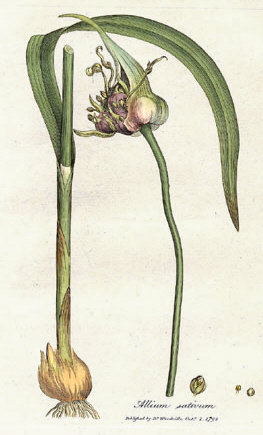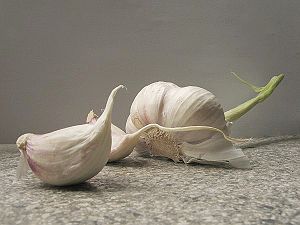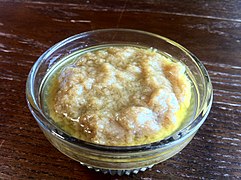Garlic/ja: Difference between revisions
Created page with "==ギャラリー== <gallery mode=packed> File:All Garlic Ail Ajo.jpg|刻んだニンニク File:Knoblauch Bluete 3.JPG|ニンニクの植物 File:Korea-Goheunggun-Garlic harvest 4196-06.JPG|収穫され乾燥中のニンニク File:A garlic clove and its head.jpg|ニンニクの鱗茎 File:Blended garlic confit.jpg|混ぜ合わせたニンニクのコンフィ </gallery>" Tags: Mobile edit Mobile web edit |
|||
| (9 intermediate revisions by the same user not shown) | |||
| Line 264: | Line 264: | ||
2つのレビューでは、ニンニクの摂取が[[colorectal cancer/ja|結腸直腸癌]]に影響を与えないことが判明した。2016年の[[case-control study/ja|症例対照研究]]および[[cohort study/ja|コホート研究]]のメタアナリシスでは、ニンニク摂取と上部[[digestive tract/ja|消化管]]の一部の癌との間に中程度の逆相関関係が認められた。 | 2つのレビューでは、ニンニクの摂取が[[colorectal cancer/ja|結腸直腸癌]]に影響を与えないことが判明した。2016年の[[case-control study/ja|症例対照研究]]および[[cohort study/ja|コホート研究]]のメタアナリシスでは、ニンニク摂取と上部[[digestive tract/ja|消化管]]の一部の癌との間に中程度の逆相関関係が認められた。 | ||
====風邪==== | |||
= | 2014年のレビューでは、ニンニクが[[common cold/ja|風邪]]の予防または治療に与える影響を決定するには不十分な証拠しか見つからなかった。他のレビューでも、ニンニクが風邪に重要な効果を持つという質の高い証拠がないと同様の結論が出されている。 | ||
[[File:Tacuinum sanitatis-garlic.jpg|thumb|15世紀の『[[:en:Tacuinum Sanitatis|タキュイヌム・サニタティス]]』より、ニンニクの収穫([[:en:Bibliothèque nationale de France|フランス国立図書館]])]] | |||
[[File:Tacuinum sanitatis-garlic.jpg|thumb| | |||
===民間療法=== | |||
ニンニクは、韓国、エジプト、日本、中国、ローマ、ギリシャなど、多様な文化において[[traditional medicine/ja|伝統医学]]として利用されてきた。[[:en:Pliny the Elder|プリニウス]]は著書『[[:en:Natural History (Pliny)|博物誌]]』の中で、ニンニクが有益であるとされた[[traditional medicine/ja|病状のリスト]]を挙げている(『博物誌』xx. 23)。2世紀に著述した[[:en:Galen|ガレノス]]は、ニンニクを「田舎者のテリヤカ」(万能薬)として称賛した(F. Adamsの『パウルス・アエギネタ』、99ページ参照)。12世紀の著述家[[:en:Alexander Neckam|アレクサンダー・ネッカム]](ライト版の著作集、1863年、473ページ参照)は、野外作業における日差しによる熱の[[palliative/ja|緩和剤]]として論じた。17世紀には、[[:en:Thomas Sydenham|トーマス・シデナム]]が合流性[[smallpox/ja|天然痘]]の塗布薬として評価し、[[:en:William Cullen|ウィリアム・カレン]]の1789年の『マテリア・メディカ』では、一部の[[dropsy/ja|浮腫]]がニンニク単独で治癒したとしている。 | |||
===その他の用途=== | |||
ニンニクの鱗片に含まれる粘着性のある汁は、ガラスや陶磁器の修理に[[:en:adhesive|接着剤]]として使われる。環境に優しいニンニク由来のポリ硫化物製品は、[[:en:European Union|欧州連合]](指令91/414の付属書1に基づく)および英国で、[[:en:nematicide|殺線虫剤]]および[[:en:insecticide|殺虫剤]]として、[[:en:cabbage root fly|アブラナハモグリバエ]]や家禽の[[:en:red mite|赤ダニ]]の駆除を含む用途で承認されている。 | |||
==文化{{Anchor|In culture}}== | |||
==In culture== | ニンニクは多くの文化の[[:en:folklore|民間伝承]]に登場する。ヨーロッパでは、多くの文化がニンニクを魔除けや[[:en:white magic|白魔術]]に利用してきたが、これはおそらく[[folk medicine/ja|民間療法]]におけるその評判に起因する。中央ヨーロッパの民間信仰では、ニンニクは[[:en:demon|悪魔]]、[[:en:werewolf|狼男]]、[[:en:vampire|吸血鬼]]に対する強力な魔除けと考えられていた。吸血鬼を追い払うために、ニンニクを身につけたり、窓に吊るしたり、煙突や鍵穴にこすりつけたりすることがあった。 | ||
古代朝鮮の[[:en:Gojoseon|古朝鮮]]の建国神話では、100日間、ニンニク20片と[[Artemisia princeps/ja|ヨモギ]]一束だけを食べた[[:en:Ungnyeo|熊が女性に変身した]]とされている。 | |||
[[:en:Nowruz|ナウルーズ]](ペルシャ暦の新年)を祝うにあたり、ニンニクは伝統的な新年の飾りである{{lang|fa-Latn|[[:en:haft-sin|haft-sin]]}}(「Sで始まる七つのもの」)の食卓に欠かせない品目の一つである。[[:en:Persian language|ペルシャ語]]でニンニクは{{lang|fa|سیر}}({{lang|fa-Latn|seer}})といい、これは「S」に対応する[[:en:Perso-Arabic|ペルシャ・アラビア文字]]の{{lang|fa|[[Shin (letter)#Arabic shīn|س]]}}({{lang|fa-Latn|sin}}、{{IPA|fa|siːn|pron}}、{{Respell|seen}})で始まる。 | |||
[[:en:Islam|イスラム教]]では、モスクに行く前に生ニンニクを食べないことが推奨されている。これはいくつかの[[:en:hadith|ハディース]]に基づいている。 | |||
一部の[[:en:Mahayana|大乗仏教徒]]や[[:en:China|中国]]、[[:en:Vietnam|ベトナム]]の宗派では、タマネギ、ニンニク、ネギ、チャイブ、リーキを食べないようにしている。これらは「五葷」({{lang-zh|c=五葷|p=Wǔ hūn}}、「五つの禁じられた辛味野菜」)として知られている。 | |||
その強い匂いから、ニンニクは「臭いバラ」と呼ばれることもある。 | |||
==ギャラリー== | |||
<gallery mode=packed> | <gallery mode=packed> | ||
File:All Garlic Ail Ajo.jpg| | File:All Garlic Ail Ajo.jpg|刻んだニンニク | ||
File:Knoblauch Bluete 3.JPG| | File:Knoblauch Bluete 3.JPG|ニンニクの植物 | ||
File:Korea-Goheunggun-Garlic harvest 4196-06.JPG| | File:Korea-Goheunggun-Garlic harvest 4196-06.JPG|収穫され乾燥中のニンニク | ||
File:A garlic clove and its head.jpg| | File:A garlic clove and its head.jpg|ニンニクの鱗茎 | ||
File:Blended garlic confit.jpg| | File:Blended garlic confit.jpg|混ぜ合わせたニンニクの[[confit/ja|コンフィ]] | ||
</gallery> | </gallery> | ||
==関連項目== | ==関連項目== | ||
Latest revision as of 19:49, 9 June 2025
| ニンニク | |
|---|---|

| |
| Allium sativum、すなわちニンニク。ウィリアム・ウッドヴィル著『Medical Botany』、1793年より | |
| Scientific classification | |
| Kingdom: | Plantae |
| Clade: | Tracheophytes |
| Clade: | Angiosperms |
| Clade: | Monocots |
| Order: | Asparagales |
| Family: | Amaryllidaceae |
| Subfamily: | Allioideae |
| Genus: | Allium |
| Subgenus: | A. subg. Allium |
| Species: | sativum
|
| Binomial name | |
| sativum | |
| Synonyms | |
|
Synonymy
| |
ニンニク(Allium sativum)は、ネギ属の鱗茎性顕花植物の種である。近縁種にはタマネギ、エシャロット、リーキ、チャイブ、ネギ、ラッキョウなどがある。ニンニクは中央アジアから南アジア、黒海から南コーカサス、イラン北東部、ヒンドゥークシュ山脈にかけての地域が原産である。また、南ヨーロッパの地中海沿岸の一部でも野生化している。ニンニクには2つの亜種と数百の品種がある。
ニンニクは何千年もの間、調味料、料理の食材、伝統的な薬として使われてきた。バビロニア人、エジプト人、ローマ人、中国人など、多くの古代文明で知られており、特に地中海沿岸やアジアを中心に、多くの料理や民間療法において重要な存在であり続けている。ニンニクは様々な気候や条件で繁殖し、世界中で生産されている。中国は2021年に世界の供給量の3分の2以上(73%)を占める最大の生産国である。
特徴
ニンニクは中央アジア、南アジア、イラン北東部が原産の多年生の顕花植物である。鱗茎から生長し、高さ1 m (3 ft)に達する直立した花茎を持つ。葉身は平らで線形、中実で、幅は約1.25–2.5 cm (0.5–1.0 in)、先端は鋭尖である。北半球では7月から9月にかけてピンクから紫色の花を咲かせることがある。鱗茎は強い臭気があり、通常10〜20個の鱗片で構成されている。中央に近い鱗片は左右対称であり、中央を囲む鱗片は非対称になることがある。各鱗片は内側の鞘状葉に包まれ、その外側を何層もの鞘状葉が覆っている。適切な時期と深さに植えれば、アラスカの北限でも栽培できる。雌雄同体の花を咲かせ、チョウ、ガ、その他の昆虫によって受粉する。
化学的性質
新鮮なニンニクや潰したニンニクからは、硫黄含有化合物であるアリシン、アホエン、ジアリルポリ硫化物、ビニルジチイン、S-アリルシステインが生成される。また、調理すると酵素、サポニン、フラボノイド、そして硫黄を含まないメイラード反応生成物が生成される。
ニンニクの刺激的な風味の原因となるフィトケミカルは、植物の細胞が損傷した際に生成される。みじん切りにしたり、噛んだり、潰したりして細胞が壊れると、細胞の液胞に蓄えられた酵素が、細胞液(細胞質ゾル)に蓄えられたいくつかの硫黄含有化合物の分解を誘発する。
ネギ属の植物の中で、ニンニクは初期反応生成物の濃度が断然高く、タマネギ、エシャロット、リーキよりもはるかに強力である。多くの人間はニンニクの味を好むが、これらの化合物は鳥、昆虫、ワームなどの動物が植物を食べるのを防ぐ防御機構として進化したと考えられている。
多数の硫黄化合物がニンニクの匂いと味に寄与している。アリシンは、生のニンニクの「辛味」の主な原因となる化合物であることが分かっている。この化学物質は、食品の熱による灼熱感に関与する熱受容体電位チャネルを開く。ニンニクを調理する過程でアリシンは除去され、辛味が和らぐ。アリシンは、その分解生成物であるジアリルジスルフィドやジアリルトリスルフィドとともに、ニンニク特有の匂いの主な原因であり、ビニルジチインやアホエンなどの他のアリシン由来化合物も寄与している。
分類
一般的に栽培されているニンニクの野生の祖先を特定することは、その多くの栽培品種が不稔であるため、野生の近縁種との交配試験が制限されるため困難である。遺伝的および形態学的に、ニンニクは中央アジアと南西アジアに自生する野生種アリウム・ロンギクスピスに最も類似している。しかし、A. longicuspisもほとんど不稔であるため、A. sativumの祖先である可能性は低い。他にも、中東原産のA.トゥンセリアナム、A.マクロカエトゥム、A.トゥルンカトゥムなどが候補として挙げられている。
Allium sativumは、野生化した地域で自生している。イギリスの「ワイルドガーリック」、「クロウガーリック」、「フィールドガーリック」は、それぞれA.ウルシヌム、A.ヴィネアレ、A.オレラケウムの種である。北米では、A.ヴィネアレ(「ワイルドガーリック」または「クロウガーリック」として知られる)とA.カナデンセ(「メドウガーリック」、「ワイルドガーリック」、または「ワイルドオニオン」として知られる)が畑の一般的な雑草である。いわゆるエレファントガーリックは、実際には野生のリーキ(A.アンペロプラサム)であり、真のニンニクではない。一片種ニンニク(パールガーリックまたはソロガーリックとも呼ばれる)は、中国の雲南省が原産である。
亜種と変種
A. sativumには2つの亜種、10の主要な変種群、そして数百の変種または栽培品種が存在する。
- A. sativum var. ophioscorodon (Link) Döllは、Ophioscorodonまたはハードネックガーリックと呼ばれ、ポーセレンガーリック、ロカンボールガーリック、パープルストライプガーリックを含む。これは時に、別の種Allium ophioscorodon G.Donと見なされることもある。
- A. sativum var. sativumは、ソフトネックガーリックと呼ばれ、アーティチョークガーリック、シルバーキンガーリック、クレオールガーリックを含む。
中央アジアを起源とする栽培品種は少なくとも120種類あり、この地域がニンニクの生物多様性の主要な中心となっている。


ニンニクの中には、英国およびEUで保護地理的表示を受けているものがあり、以下が含まれる。
| 名前 | 産地 |
|---|---|
| アリオ・ロッソ・ディ・ヌビア(ヌビアの赤ニンニク) | ヌビア-パチェーコ、トラーパニ県、シチリア島、イタリア |
| アリオ・ビアンコ・ポレサーノ | ロヴィーゴ県、ヴェネト州、イタリア(PDO) |
| アリオ・ディ・ヴォギエーラ | フェラーラ県、エミリア=ロマーニャ州、イタリア(PDO) |
| アイル・ブラン・ド・ロマニュー | ガスコーニュ地方ロマニュー、フランス(PGI) |
| アイル・ド・ラ・ドローム | ドローム県、フランス(PGI) |
| アイル・ローズ・ド・ロートレック(ロートレックのバラ色/ピンクニンニク) | ロートレック、フランス(PGI) |
| アイル・ヴィオレ・ド・カドゥール | カドゥール、フランス(PDO) |
| アホ・モラード・デ・ラス・ペドロニェラス(ラス・ペドロニェラスの紫/ピンクニンニク) | ラス・ペドロニェラス、スペイン(PGI) |
| 金郷大蒜 | 中国(PGI) |
| タシュキョプリュ・サルムサウ | トルコ(PDO) |
語源
「garlic」という言葉は、古英語の「garlēac」に由来し、「gar」(槍)と「リーキ」を意味し、「槍の形をしたリーキ」を指す。
生態
ニンニクの植物は通常丈夫で、多くの病害虫の影響を受けにくい。ニンニクの植物はウサギやモグラを寄せ付けないと言われている。カリフォルニア州食品農業局は、線虫とStromatinia cepivoraによって引き起こされる白腐病の2つの病原体(これらは作物に壊滅的な被害を与え、一度土壌に侵入すると永久的に残存する可能性がある)がないことを保証するための認証プログラムを実施している。ニンニクはまた、通常は致命的ではないが、根の成長を阻害し、根をピンクまたは赤に変色させる「ピンク根病」、あるいは通常明るいオレンジ色の斑点として現れる「リーキさび病」に罹患することもある。ネギガの幼虫は、葉や鱗茎に潜り込んでニンニクを食害する。
ボトリティスによる茎葉および鱗茎腐敗病は、タマネギ、ニンニク、リーキ、エシャロットの病気である。Botrytis alliiとBotrytis acladaはタマネギに、Botrytis porriはニンニクにこの病気を引き起こす。カリフォルニア大学によると、以下の症状が初期症状として現れる。<brockquote> 初期症状は通常、茎葉の付け根部分から始まり、罹患した組織は軟化し、水浸しになり、褐色に変色する。湿度の高い環境では、腐敗した鱗片上に灰色でフェルト状の菌糸(胞子が生成される場所)が現れ、鱗片間に菌糸体が発達することもある。最終的には、茎葉の付け根部分または鱗片間に、暗褐色から黒色の菌核(病原体の休眠体)が発達することがある。</brockquote>
栽培

ニンニクは栽培が容易で、温暖な気候では一年中生育する。ニンニクの有性生殖も可能だが、現在栽培されているニンニクのほとんどは、個々の鱗片を地面に植えることで無性的に繁殖させている。寒冷な気候では、土壌が凍る約6週間前に鱗片を植えるのが最適とされている。これは、鱗茎に根だけを生やし、地上に芽を出させないことが目的である。収穫は晩春から初夏にかけて行われる。
ニンニクの植物は、鱗茎が成熟するのに十分なスペースを残して密接に栽培でき、十分な深さの容器でも容易に育てられる。ニンニクは、日当たりの良い場所で、緩く、乾燥した、水はけの良い土壌でよく育ち、USDA耐寒性ゾーン4〜9で丈夫に育つ。植え付け用のニンニクを選ぶ際は、大きな鱗茎から鱗片を分けることが重要である。大きな鱗片と、植え付け床での適切な間隔が、鱗茎のサイズを大きくする。ニンニクの植物は、有機物含有量の高い土壌での生育を好むが、幅広い土壌条件とpHレベルで生育できる。
ニンニクには様々な品種があり、特にハードネックガーリックとソフトネックガーリックの亜種に分けられる。ニンニクは日長に敏感なため、栽培される緯度が品種の選択に影響する。ハードネックガーリックは一般的に冷涼な気候で栽培され、比較的大きな鱗片を生成するのに対し、ソフトネックガーリックは一般的に赤道に近い場所で栽培され、小さく密に詰まった鱗片を生成する。
ニンニクの花茎は、ニンニクの全てのエネルギーを鱗茎の成長に集中させるために除去される。花茎は生でも調理しても食べられる。

繁殖
ニンニクを鱗片から繁殖させる方法は、株分けと呼ばれる。生産目的のニンニクの無性繁殖には、品種によって異なる低温が必要である。ハードネック種は長時間の低温暴露を必要とする一方、ソフトネック種はより温暖な気候でよく育つ。この低温気候は、複数の鱗片を持つ鱗茎の生育に必要な、鱗片の層化の一種である春化処理に必要である。一片種ニンニクは、春化処理なしで栽培されたニンニクの結果である。
生産
| 国 | 百万トン |
|---|---|
| 20.5 | |
| 3.2 | |
| 0.8 | |
| 0.5 | |
| 0.3 | |
| 0.3 | |
| 世界 | 28.2 |
2021年の世界のニンニク生産量は2,800万トンであり、中国が全体の73%を占めた。
-
鱗茎(頂生で、花の代わりに栽培されたもの)
-
ニンニク、ヘンリー・マンソン・ライマン著『The Book of Health』、1898年より
有害作用と毒性
ニンニクの香りは人体に残り、口臭や体臭の原因となることが知られている。これは硫化アリルメチル(AMS)によって引き起こされる。AMSは揮発性の液体で、ニンニク由来の硫黄化合物の代謝中に血液中に吸収される。血液から肺(そこから口へ移動し、ニンニク臭の原因となる)と皮膚に運ばれ、皮膚の毛穴から排出される。消化には数時間、AMSの排出にはさらに数時間かかるため、ニンニクを食べた効果は長時間持続する可能性がある。石鹸で皮膚を洗うことは、臭いを部分的にしか、そして不完全にしか解決しない。研究によると、ニンニクを摂取すると同時に牛乳を飲むと、口臭を大幅に中和できることが示されている。ニンニクを飲み込む前に口の中で牛乳と混ぜると、牛乳を後から飲むよりも臭いが軽減された。ただの水、キノコ、バジルも臭いを軽減する可能性があるが、牛乳に含まれる脂肪と水の混合物が最も効果的だった。ニンニクの臭いは、新鮮なパセリを食べることによって軽減されると言われている。
ニンニクに豊富に含まれる硫黄化合物は、ピクルスや調理中にニンニクが緑色や青色に変色する原因でもある。これらの条件下(すなわち、酸性度、熱)では、硫黄含有化合物アリインが一般的なアミノ酸と反応してピロール(炭素と窒素の環の集合体)を生成する。これらの環は結合してポリピロール分子になることがある。環状構造は特定の波長の光を吸収するため、色が付いて見える。2つのピロール分子は赤色、3つのピロール分子は青色、4つのピロール分子は緑色(クロロフィルのようなテトラピロール)に見える。クロロフィルと同様に、ピロール色素は食べても安全である。切断時に、アミノ酸と硫黄化合物の反応によってタマネギが変色するのと同様に、ニンニクも緑色に変色することがある。
ニンニクの鱗片の中心にある緑色で乾燥した「ひだ」は特に辛味が強い。新鮮なニンニクを潰したり噛んだりすることで生成される硫黄化合物アリシンは、他の硫黄化合物であるアホエン、アリルポリ硫化物、ビニルジチインを生成する。熟成ニンニクにはアリシンは含まれないが、S-アリルシステインの存在によりある程度の活性がある可能性がある。
ニンニクや他のネギ属の植物に対してアレルギーを持つ人々もいる。症状には、過敏性腸症候群、下痢、口や喉の潰瘍、吐き気、呼吸困難、そして稀にアナフィラキシーが含まれる。ニンニクに過敏な人々は、ニンニクに含まれるジアリルジスルフィド、アリルプロピルジスルフィド、アリルメルカプタン、アリシンに対して陽性反応を示す。ニンニクアレルギーを持つ人々は、タマネギ、チャイブ、リーキ、エシャロット、ユリ科の植物、ショウガ、バナナなど、他の多くの植物にも過敏である場合が多い。

自然療法やニキビ治療など、様々な目的でニンニクを局所的に使用したことによる重度の火傷の報告がいくつかあり、これらの用途には注意が必要で、通常は低濃度のニンニクを使って皮膚の小さな部分でテストする必要がある。子供への火傷を含む多数の火傷の報告に基づいて、生ニンニクの局所使用、および生ニンニクを体腔に挿入することは推奨されない。特に、幼児への生ニンニクの局所適用は推奨されない。
ニンニクを長期にわたって摂取した場合の副作用はほとんど分かっていない。考えられる副作用には、胃腸の不快感、発汗、めまい、アレルギー反応、出血、月経不順などがある。
一部の授乳中の母親は、ニンニクを摂取した後、赤ちゃんが乳を飲むのが遅くなり、ニンニクの匂いがすると感じたことがある。

推奨量以上のニンニクを抗凝固薬と一緒に摂取すると、出血のリスクが高まる可能性がある。ニンニクは、ワルファリン、サキナビル、降圧薬、カルシウム拮抗薬、シプロフロキサシンなどのキノロン系抗生物質、および血糖降下薬、その他の薬剤と相互作用する可能性がある。米国獣医学会は、ニンニクをペットにとって毒性があるとみなしている。
 | |||||||||||||||||||||||||||||||||||||||||||||
| 100 g (3.5 oz)あたりの栄養価 | |||||||||||||||||||||||||||||||||||||||||||||
|---|---|---|---|---|---|---|---|---|---|---|---|---|---|---|---|---|---|---|---|---|---|---|---|---|---|---|---|---|---|---|---|---|---|---|---|---|---|---|---|---|---|---|---|---|---|
| エネルギー | 623 kJ (149 kcal) | ||||||||||||||||||||||||||||||||||||||||||||
33.06 g | |||||||||||||||||||||||||||||||||||||||||||||
| 砂糖 | 1 g | ||||||||||||||||||||||||||||||||||||||||||||
| 食物繊維 | 2.1 g | ||||||||||||||||||||||||||||||||||||||||||||
0.5 g | |||||||||||||||||||||||||||||||||||||||||||||
6.36 g | |||||||||||||||||||||||||||||||||||||||||||||
| |||||||||||||||||||||||||||||||||||||||||||||
| その他の成分 | 量 | ||||||||||||||||||||||||||||||||||||||||||||
| 水 | 59 g | ||||||||||||||||||||||||||||||||||||||||||||
| セレン | 14.2 μg | ||||||||||||||||||||||||||||||||||||||||||||
| †割合は、カリウムを除き、成人に対する米国 推奨値を使用して推定された。カリウムは、全米科学・工学・医学アカデミーの専門家による推奨に基づき推定された。 | |||||||||||||||||||||||||||||||||||||||||||||
利用
ニンニクを摂取すると、血液中に硫黄化合物が循環するため、蚊よけとして作用する可能性があるが、その有効性を示す科学的証拠はない。
栄養
ニンニクの一般的な摂取量である1〜3片(3〜9グラム)では、生ニンニクは栄養価が低く、すべての必須栄養素の含有量は1日摂取量(DV)の10%未満である。100 g (3.5 oz)の基準量では、生ニンニクはビタミンB6(DVの73%)とビタミンC(DVの35%)、およびミネラルのマンガン(DVの73%)など、一部の微量栄養素を豊富に(DVの20%以上)含む。100グラムあたりの生ニンニクは、ビタミンB群のチアミンとパントテン酸、ならびにミネラルのカルシウム、カリウム、リン、亜鉛の適度な供給源(DVの10〜19%)である。
生ニンニクの組成は、水分59%、炭水化物33%、タンパク質6%、食物繊維2%、脂質1%未満である。
料理での利用


ニンニクは、その強い風味から世界中で調味料や香辛料として広く使われている。
ニンニクの植物の中で最も一般的に利用されるのは鱗茎である。一片種を除いて、ニンニクの鱗茎は通常、多数の肉厚な部分に分かれており、これらは鱗片と呼ばれる。ニンニクの鱗片は食用(生または加熱調理)や薬用として利用される。特有の刺激的で辛い風味があるが、加熱するとかなりまろやかになり甘みが増す。その特徴的な香りは、主に生のニンニクの鱗片に含まれる有機硫黄化合物であるアリシンや、潰したり刻んだりしたときに生成されるアホエンによるものである。さらに、代謝物である硫化アリルメチルは、ニンニクの口臭の原因となる。
ニンニクの他の部分も食用になります。茎や花(ムカゴ)は、花序(仏炎苞)についている部分が食べられることもある。これらは鱗茎よりも風味が穏やかで、未成熟で柔らかい時期に食べられることが多い。未成熟なニンニクは、ネギのように引き抜かれ、「グリーンガーリック」として販売されることがある。グリーンガーリックを「ネギ」の段階を過ぎても完全に成熟させずに育てると、熟成した鱗茎のように鱗片に分かれず、茹で玉ねぎのような丸いニンニク「ガーリックラウンド」ができることがある。
グリーンガーリックは、辛味がないニンニクの風味と香りを料理に与えます。グリーンガーリックは、東南アジア(ベトナム、タイ、ミャンマー、ラオス、カンボジア、シンガポールなど)や中華料理で、しばしば刻んで炒め物やスープ、鍋料理に使われ、非常に豊富で安価である。さらに、ハードネック種の未熟な花茎(スカープ)は、炒め物でアスパラガスのように利用されることもある。

ニンニクの植物の食用にならない部分、またはほとんど食べられない部分としては、各鱗片を覆う「皮」と根の塊がある。植物の様々な部分を覆う紙のような保護層の「皮」は、ほとんどの料理の準備中に通常は捨てられるが、韓国では未熟なニンニクの頭全体が、柔らかい皮を付けたまま調理されることもある。鱗茎の基盤に付着している根の塊は、どのような形でも通常は美味とは見なされない唯一の部分である。
別の方法として、鱗茎のてっぺんを切り落とし、オリーブオイル(または他の油ベースの調味料)をかけて鱗片を覆い、オーブンでローストする方法がある。ニンニクは柔らかくなり、鱗茎の(根のある)端を絞るか、個々の鱗片の片端を絞ることで中身を取り出すことができる。韓国では、ニンニクの頭を数週間にわたって加熱する。その結果できる「黒ニンニク」と呼ばれる製品は甘くシロップ状で、アメリカ、イギリス、オーストラリアに輸出されている。
ニンニクは、様々な種類のパンにバターや油を介して塗られ、ガーリックブレッド、ガーリックトースト、ブルスケッタ、クロスティーニ、カナッペなど、様々な古典的な料理が作られる。風味の強さと香りは、調理法によって異なる。しばしばタマネギ、トマト、ショウガと組み合わせられる。

未熟なスカープは柔らかく食用です。「ガーリックスピア」、「ステム」、または「トップス」とも呼ばれる。スカープは通常、鱗片よりも味が穏やかです。炒め物に使われたり、アスパラガスのように煮込んだりすることがよくある。ニンニクの葉は、アジアの多くの地域で人気の野菜である。葉は刻んで洗浄され、卵、肉、または野菜と一緒に炒められる。
ガーリックパウダーは乾燥させたニンニクから作られ、新鮮なニンニクの代わりとして使用できるが、味は全く同じではない。ガーリックソルトはガーリックパウダーと食塩を組み合わせたものである。
地域別の利用

ニンニクは、東アジア、南アジア、東南アジア、中東、北アフリカ、南ヨーロッパ、東ヨーロッパ、ラテンアメリカの一部など、様々な地域の多くの料理において基本的な食材である。特にラテンアメリカの調味料では、ソフリートやモフォンゴにニンニクが使われる。
油にニンニクの鱗片で風味をつけることもできる。これらの風味付けされた油は、あらゆる種類の野菜、肉、パン、パスタの調味料として使われる。ニンニクは、魚醤、刻んだ生の唐辛子、ライムジュース、砂糖、水とともに、インドシナで広く使われるつけ魚醤という、非常に多用されるつけだれ調味料の基本的な必須アイテムである。東アジアや東南アジアでは、ニンニク入りのチリオイルが、特に肉や魚介類によく合うつけだれとして人気がある。トゥオン・オット・トイ・ベトナム(ベトナムチリガーリックソース)は、北米やアジアで非常に人気のある調味料およびつけだれである。
一部の料理では、若い鱗茎を砂糖、塩、スパイスの混合液に3〜6週間漬け込む。東ヨーロッパでは、芽がピクルスにされ、前菜として食べられる。酢にニンニクを漬けて作る臘八ニンニクは、中国の旧正月を祝う際に、中国北部で餃子と一緒に供されるピクルスニンニクの一種である。
ニンニクは中東料理やアラブ料理において不可欠な要素であり、多くの料理に使われています。特にレバント地方では、伝統的にニンニクをオリーブオイルと、時には塩と一緒に潰して、トゥーム(アラビア語で「ニンニク」の意)と呼ばれる中東のニンニクソースを作る。トゥームは肉料理に限らず、鶏肉やシャワルマなどの肉料理によく添えられる。また、ニンニクはフムス(ひよこ豆、タヒニ、ニンニク、レモン汁、塩からなるアラブのディップ)の一部の品種において重要な要素である。
軽くスモークしたニンニクは、イギリス料理や他のヨーロッパ料理で使われる。特に、鶏肉やジビエの詰め物、スープ、シチューで重宝される。
ニンニクとオリーブオイルを乳化させると「アイオリ」ができる。ニンニク、油、そしてゴロゴロしたベースを混ぜると「スコルダリア」ができる。潰したニンニク、油、水から作られる風味の強いソースは「ムジデイ」です。ニンニク、アーモンド、油、浸したパンを混ぜると「アホブランコ」ができる。ヨーグルトとニンニク、塩を混ぜた「ザジキ」は、東地中海料理で一般的なソースである。
料理の歴史
多数の楔形文字の記録から、ニンニクはメソポタミアで少なくとも4,000年にわたって栽培されてきたことが示されている。中国やエジプトにおけるニンニクの使用も数千年前から遡る。保存状態の良いニンニクがツタンカーメンの墓(紀元前1325年頃)で発見された。古代ギリシャやローマの兵士、船乗り、農民階級(ウェルギリウス、『牧歌』ii. 11)、そしてプリニウス(博物誌)(『博物誌』xix. 32)によればアフリカの農民によっても消費されていた。古代ギリシャでは、ヘカテーへの夕食として、道端の石塚の上にニンニクが置かれた(テオプラストス、『人となり』「迷信家」)。
ニンニクは伝統的なイギリス料理では稀であったが(1548年以前からイングランドで栽培されていたと言われている)、地中海沿岸のヨーロッパでは一般的な食材であった。13世紀に一般的に遡るとされる度量衡規定(イングランドの法規)のc. 1300年頃の翻訳には、ニンニク生産、販売、課税の標準化された単位、すなわち15個の束(各束15個の頭)からなるハンドレッドについて言及している箇所があるが、ラテン語版の原文はニンニクではなくニシンを指している可能性がある。
保存方法

家庭では、ニンニクは発芽を抑制するために、暖かく(18℃以上)乾燥した場所で休眠状態で保存されます。伝統的には吊るして保存され、ソフトネック種はしばしば「ブレード」や「グラップ」と呼ばれる房に編み込まれる。皮をむいた鱗片は、冷蔵庫でワインや酢に浸して保存できる。商業的には、ニンニクは乾燥した低湿度の環境で0℃で保存される。葉が付けたままの方が長持ちする。
ニンニクは風味付けされた油を作るために油に漬けて保存されることが多いですが、この方法では、ニンニクが酸敗したり、ボツリヌス菌が増殖したりするのを防ぐための対策が必要である。酢の薄い溶液で酸性にすることで、細菌の増殖を最小限に抑えられる。冷蔵庫での保存でも、油に漬けたニンニクの安全は保証されないため、細菌による腐敗を避けるためには1ヶ月以内に使い切る必要がある。
保存中のニンニクは、特に湿度が高い場合に「青カビ病」(一部の地域では「緑カビ病」)として知られるペニシリウムによる腐敗の影響を受けることがある。感染はまず、柔らかい、または水浸しの斑点として現れ、その後白い斑点(菌糸体)が現れ、胞子形成によって青または緑に変色する。低温では胞子形成と発芽が遅れ、-4℃では完全に阻害されるため、冷蔵保存された鱗片では初期段階で白い菌糸体のみが見られることがある。ペニシリウム・ヒルスタムとペニシリウム・アリイは、青カビ病で特定された主要な種のうちの2つである。
医学研究
循環器
2016年の時点で、臨床研究では、ニンニクの摂取が血圧をわずかに(4mmHg)低下させるに過ぎず、高血圧、心血管系の罹患率、または死亡率に対する明確な長期的な効果はないことが判明している。2016年のメタアナリシスでは、ニンニクの摂取がアテローム性動脈硬化症のバイオマーカーであるリポタンパク質(a)の血中濃度に影響を与えないことが示された。
ニンニクは血小板凝集を抑制する可能性があるため、抗凝固薬を服用している人はニンニクの摂取に注意が必要である。
がん
2つのレビューでは、ニンニクの摂取が結腸直腸癌に影響を与えないことが判明した。2016年の症例対照研究およびコホート研究のメタアナリシスでは、ニンニク摂取と上部消化管の一部の癌との間に中程度の逆相関関係が認められた。
風邪
2014年のレビューでは、ニンニクが風邪の予防または治療に与える影響を決定するには不十分な証拠しか見つからなかった。他のレビューでも、ニンニクが風邪に重要な効果を持つという質の高い証拠がないと同様の結論が出されている。

民間療法
ニンニクは、韓国、エジプト、日本、中国、ローマ、ギリシャなど、多様な文化において伝統医学として利用されてきた。プリニウスは著書『博物誌』の中で、ニンニクが有益であるとされた病状のリストを挙げている(『博物誌』xx. 23)。2世紀に著述したガレノスは、ニンニクを「田舎者のテリヤカ」(万能薬)として称賛した(F. Adamsの『パウルス・アエギネタ』、99ページ参照)。12世紀の著述家アレクサンダー・ネッカム(ライト版の著作集、1863年、473ページ参照)は、野外作業における日差しによる熱の緩和剤として論じた。17世紀には、トーマス・シデナムが合流性天然痘の塗布薬として評価し、ウィリアム・カレンの1789年の『マテリア・メディカ』では、一部の浮腫がニンニク単独で治癒したとしている。
その他の用途
ニンニクの鱗片に含まれる粘着性のある汁は、ガラスや陶磁器の修理に接着剤として使われる。環境に優しいニンニク由来のポリ硫化物製品は、欧州連合(指令91/414の付属書1に基づく)および英国で、殺線虫剤および殺虫剤として、アブラナハモグリバエや家禽の赤ダニの駆除を含む用途で承認されている。
文化
ニンニクは多くの文化の民間伝承に登場する。ヨーロッパでは、多くの文化がニンニクを魔除けや白魔術に利用してきたが、これはおそらく民間療法におけるその評判に起因する。中央ヨーロッパの民間信仰では、ニンニクは悪魔、狼男、吸血鬼に対する強力な魔除けと考えられていた。吸血鬼を追い払うために、ニンニクを身につけたり、窓に吊るしたり、煙突や鍵穴にこすりつけたりすることがあった。
古代朝鮮の古朝鮮の建国神話では、100日間、ニンニク20片とヨモギ一束だけを食べた熊が女性に変身したとされている。
ナウルーズ(ペルシャ暦の新年)を祝うにあたり、ニンニクは伝統的な新年の飾りであるhaft-sin(「Sで始まる七つのもの」)の食卓に欠かせない品目の一つである。ペルシャ語でニンニクはسیر(seer)といい、これは「S」に対応するペルシャ・アラビア文字のس(sin、fa、seen)で始まる。
イスラム教では、モスクに行く前に生ニンニクを食べないことが推奨されている。これはいくつかのハディースに基づいている。
一部の大乗仏教徒や中国、ベトナムの宗派では、タマネギ、ニンニク、ネギ、チャイブ、リーキを食べないようにしている。これらは「五葷」(Chinese: 五葷; pinyin: Wǔ hūn、「五つの禁じられた辛味野菜」)として知られている。
その強い匂いから、ニンニクは「臭いバラ」と呼ばれることもある。
ギャラリー
-
刻んだニンニク
-
ニンニクの植物
-
収穫され乾燥中のニンニク
-
ニンニクの鱗茎
-
混ぜ合わせたニンニクのコンフィ
関連項目
外部リンク
 Data related to Allium sativum at Wikispecies
Data related to Allium sativum at Wikispecies The dictionary definition of garlic at Wiktionary
The dictionary definition of garlic at Wiktionary
| この記事は、クリエイティブ・コモンズ・表示・継承ライセンス3.0のもとで公表されたウィキペディアの項目Garlic(2 June 2025, at 21:34編集記事参照)を翻訳して二次利用しています。 |







